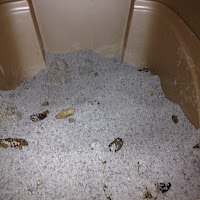 |
| Weeds blocking access to the composter. Planter waiting for a spot. |
I had this question, recently, and figured others were
likely wondering the same thing!
A green roof is not a wild roof because there are structural
issues. Seeds travel on the wind and by
bird poop. As much as we would love to
see milkweed for the monarch butterflies and a small tree for birds, the roof
cannot support the weight or the invasiveness of the roots.
A green roof has a variety of plants that are sturdy, drought
resistant and have really shallow roots.
Deep roots could break through the roof membrane. If that happens, there will be all kinds of structural
issues with water getting where it is not supposed to go.
There is a contractor for our building who only takes care
of the section of the green roof that we don’t have access to. The original contractor was responsible for
the entire green roof. Now, as with all
other CCOC rooftop gardens, the Metcalfe gardeners receive a plot in exchange
for keeping our section of the roof weeded and clean.
 |
| Weeds behind planters with a planter nobody in the community garden on the ground wanted. Apparently, the roof won't handle the weight of the planter in the winter, yet it sits there looking like garbage. By managing our green space, maybe we won't become the dumping ground. |
At the meeting on Sunday 23 June 2015, the Metcalfe
gardeners recognized that there were many deep rooted weeds and that the roof
looked unkempt as opposed to wild.
 |
| Patio tiles with weeds growing. Eventually, Mother Nature will crack our tiles and the roof will look even more unkempt. We have a new tool to make weeding this easy, though! |
Our
rooftop has the potential of being a beautiful, organic, food secure habitat
for pollinators and people, while lowering the carbon footprint of the
community below the roof. We also want it to be easy to maintain.
We came up with a concept, with the view to filling in the
details in the near future. The group
decided which plants we definitely wanted to keep. Evelyn was supported in wanting a section to
be for wild, native plants. Overwhelmingly,
the group wanted to add plants that were either edible or valuable food sources for
pollinators. The CCOC Garden Facilitator
let us know that the roof was not toxic for growing food, but that it is not
nutrient rich; this will be a challenge in selecting plants that will thrive.
Michael and Robert were the first to start weeding (14 hours in a small area); they found one section with ridiculously
invasive roots. It became evident that
the plan to get rid of almost everything and start again was a sound decision.
Over the next couple of weeks, while we are weeding, ideas
will flow. At the next meeting, we will
zero in on which plants we want and then figure out how to get them. Those who can’t make the meeting – it is
summer vacation time – are encouraged to send suggestions via the rooftop
coordinator.
We weed the roof to make our home lovely and safe.




























